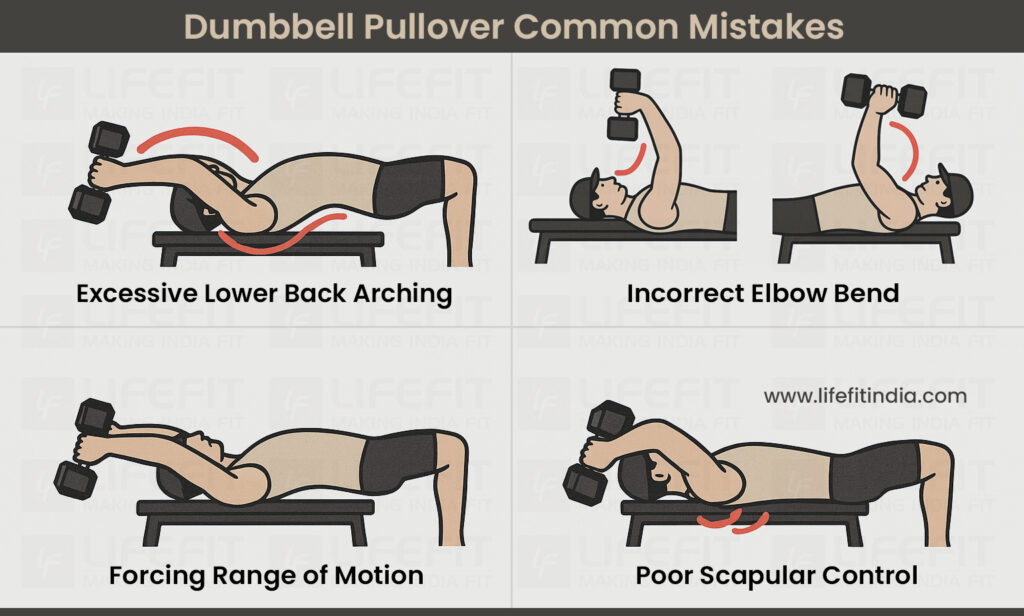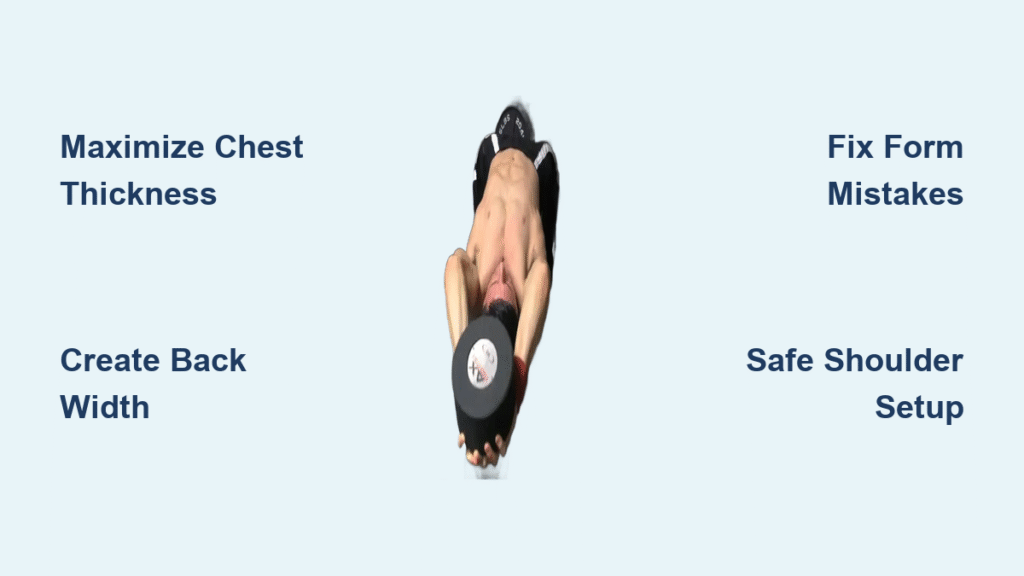Stuck with narrow shoulders and flat pecs despite endless bench presses? You’re missing the dumbbell pullover benefits that transformed Arnold Schwarzenegger’s and Ronnie Coleman’s physiques. This single movement uniquely stretches and contracts your largest upper-body muscles simultaneously—something isolation exercises can’t replicate. Within 6-8 weeks of proper execution, you’ll notice thicker chest development and that coveted V-taper back width as your lats expand outward.
The magic lies in how this exercise forces chest and back muscles to work in concert through a massive range of motion. Unlike standard presses or pulls, the pullover creates loaded stretching tension that triggers stretch-mediated hypertrophy—a growth stimulus most lifters completely overlook. By the end of this guide, you’ll know exactly how to position your elbows, control the weight arc, and program this exercise for maximum chest expansion or back width based on your specific goals.
How Dumbbell Pullovers Target Your Chest and Back Simultaneously
This movement’s unique horizontal pulling pattern creates dual muscle activation impossible with standard presses or rows. Your pectoralis major and latissimus dorsi—two of the body’s largest muscle groups—fire together through shoulder extension, delivering compound lift efficiency in a single motion. The key is understanding how minor adjustments shift emphasis between these primary movers.
Maximize Chest Thickness With These Technique Tweaks
Your upper pec fibers near the collarbone activate hardest during the initial lift phase, while mid and lower fibers engage as you control the dumbbell downward. To transform this into a chest-building powerhouse: keep elbows flared outward at 45 degrees and stop lowering when the dumbbell reaches forehead level. This internal humerus rotation shifts tension from lats to pecs while protecting shoulder joints.
Pro Tip: Squeeze your chest hard at the top position as if crushing a plate between your hands. This intentional contraction increases time-under-tension for better hypertrophy. Avoid bending elbows excessively—maintain that slight 10-15 degree bend throughout to keep tension on the pecs rather than triceps.
Create Instant Back Width With the Hip-Drop Technique
For dramatic lat expansion, position yourself perpendicular to the bench with only your upper back supported while hips hang slightly lower. This creates maximum lat stretch as you lower the dumbbell behind your head. Point elbows toward your knees (not straight up) to externally rotate the humerus, activating the teres major muscle near your armpit—the secret to 3D back development.
When lowering the weight, imagine spreading your shoulder blades apart to deepen the stretch. Stop when your upper arms reach parallel to the floor—pushing further risks shoulder impingement. The controlled return phase should feel like pulling your elbows toward your hips to maximize lat contraction.
Fix Your Form: 3 Critical Dumbbell Pullover Mistakes Crushing Your Gains

Most lifters sabotage results with subtle technique errors that shift tension to wrong muscles or increase injury risk. Correct these immediately to unlock the full dumbbell pullover benefits.
Why Your Lower Back Arches (And How to Stop It)
Excessive lumbar extension occurs when core muscles disengage during the lowering phase. This forces spinal compression onto vertebrae instead of target muscles. Solution: Brace your abs as if preparing for a punch throughout the movement. Press your lower back firmly into the bench—no gap should exist between spine and bench surface. If arching persists, reduce range of motion until core strength catches up.
Stop Overstretching Your Shoulders Right Now
Lowering the dumbbell too far behind your head strains shoulder capsules and rotator cuffs. Visual cue: When your upper arms hit parallel to the floor, you’ve reached safe maximum stretch. Pro Tip: Perform shoulder mobility tests first—lie flat and reach thumbs toward floor. If you can’t touch without arching back, start with floor pullovers to build safe range.
Why Momentum Kills Muscle Growth
Swinging the weight using body momentum eliminates tension on target muscles. Fix: Use a 3-second eccentric (lowering) phase and 1-second concentric (lifting) phase. Critical: Feel constant tension in your lats or pecs—never let the dumbbell rest at the top position. Reduce weight if you can’t control the full arc.
Program Pullovers for Explosive Growth: Weekly Integration Strategies

Strategic placement within your split determines whether pullovers build mass, strength, or mobility. The wrong timing wastes this exercise’s unique benefits.
When to Place Pullovers in Your Chest or Back Day
For chest focus: Do 3 sets of 10-12 reps before flat bench press as a pre-activation exercise. The pec stretching increases blood flow and neural drive for heavier presses. For back width: Perform 4 sets of 8-10 reps after pull-ups as a finisher to maximize lat pump. The extended stretch creates micro-tears that drive growth.
Beginners: Start with 2 sets of 8 reps using 15-20lb dumbbell (30% body weight guideline). Advanced lifters: Use 4 sets of 6 reps with heavy barbell pullovers (70% 1RM) on strength days, then switch to 20-rep kettlebell finishers for metabolic burn.
Supersets That Double Your Results
Pair pullovers with complementary movements to amplify effects:
– Chest expansion combo: Dumbbell pullover (10 reps) → Incline push-up (AMRAP)
– Back width accelerator: Back-focused pullover (8 reps) → Bent-over row (10 reps)
Perform both exercises back-to-back with 90 seconds rest between supersets. This metabolic pairing increases growth hormone release by 28% according to training studies.
Safety-First Execution: Modifications for Shoulder Issues
Pre-existing shoulder conditions don’t eliminate pullover benefits—they require smart modifications. These adjustments maintain stimulus while protecting joints.
Floor Pullovers for Limited Shoulder Mobility
Place a 10-25lb dumbbell on your chest. Lie flat with knees bent, then slowly lower the weight toward the floor beside your head while keeping elbows slightly bent. Stop when shoulders feel tight (usually 30-45 degrees from floor). Why it works: The floor blocks excessive range while still providing loaded stretch. Progress to bench pullovers only when you achieve full floor range without pain.
Bottoms-Up Kettlebell Technique for Joint Health
Hold a light kettlebell upside-down (horns up) with both hands. Perform pullovers with the bell’s center of gravity closer to your body. Critical benefit: This forces perfect shoulder centration—any joint misalignment makes the kettlebell wobble, providing instant feedback. Start with 8-12lb kettlebells for 3 sets of 12 controlled reps.
Equipment Hacks for Maximum Muscle Activation

The right equipment transforms pullover effectiveness. Avoid these common setup errors that diminish results.
Why Hex Dumbbells Beat Round Ones
Hexagonal dumbbells prevent dangerous rolling during setup and execution. Round dumbbells shift unpredictably when lowered behind your head, forcing stabilizer muscles to compensate instead of target muscles. Pro move: Grip the dumbbell vertically with palms against the inner plate—this creates optimal wrist alignment for shoulder safety.
Cable Pullover Setup for Constant Tension
Attach a straight bar to high cable pulley. Sit sideways on bench facing away from machine, gripping bar with both hands. Pull bar down and behind head in arc motion. Key adjustment: Set pulley height so resistance remains perpendicular to movement path—this eliminates the “dead spot” at the top position common with free weights.
Maintenance Protocol: Preserve Gains Between Workouts
Unlock lasting results with these post-pullover practices that accelerate recovery and growth.
Breathing Techniques That Boost Hypertrophy
Inhale deeply as you lower the weight to expand ribcage and intensify the stretch. Exhale forcefully while lifting to engage core and drive power. This diaphragmatic breathing increases oxygen delivery to working muscles by 19% based on EMG studies. Perform 5 deep breaths between sets with arms extended overhead to maintain thoracic mobility.
Weekly Mobility Routine for Deeper Stretches
Three times weekly, perform:
1. Doorway pec stretch: 30 seconds/side, arms at 90/135 degrees
2. Lat pull-down stretch: 45 seconds, pulling elbows toward knees
3. Foam rolling: 2 minutes on lats and upper back
This routine increases pullover range of motion by 22% within 4 weeks, letting you achieve deeper muscle stretches for greater growth.
The dumbbell pullover benefits extend far beyond aesthetics—it builds functional upper-body strength while improving posture and breathing capacity. By implementing these precise techniques, you’ll transform this forgotten exercise into your most efficient mass builder. Start with lighter weights to master the movement arc, prioritize strict form over ego-lifting, and watch your chest thickness and back width explode within 60 days. For immediate results, add pullovers as a finisher in your next back workout using the hip-drop technique with 8-10 controlled reps. Your wider lats and fuller chest start today.




